Geochemistry, Zircon U-Pb Geochronology and Hf-O Isotopes of the Banzhusi Granite Porphyry from the Xiong’ershan Area, East Qinling Orogen, China: Implications for Petrogenesis and Geodynamics
Abstract
:1. Introduction
2. Geological Setting
3. Sampling and Analytical Methods
3.1. Samples
3.2. Whole-Rock Geochemistry
3.3. Zircon U-Pb Analysis
3.4. Zircon Lu-Hf Analysis
3.5. Zircon O Isotope Analysis
4. Results
4.1. Whole-Rock Geochemistry
4.2. Zircon U-Pb Ages
4.3. Zircon Lu-Hf Isotope Compositions
4.4. Zircon O Isotope Compositions
5. Discussion
5.1. Petrogenesis of the Banzhusi Granite Porphyry
5.2. Relationship between the Banzhusi Granite Porphyry and Mineralization
5.3. Geodynamic Implications
6. Conclusions
Author Contributions
Funding
Acknowledgments
Conflicts of Interest
References
- Li, N.; Chen, Y.J.; Santosh, M.; Pirajno, F. Late Mesozoic granitoids in the Qinling Orogen, Central China, and tectonic significance. Earth-Sci. Rev. 2018, 182, 141–173. [Google Scholar] [CrossRef]
- Mao, J.; Xie, G.; Pirajno, F.; Ye, H.; Wang, Y.; Li, Y.; Xiang, J.; Zhao, H. Late Jurassic–Early Cretaceous granitoid magmatism in Eastern Qinling, central-eastern China: SHRIMP zircon U-Pb ages and tectonic implications. Aust. J. Earth Sci. 2010, 57, 51–78. [Google Scholar] [CrossRef]
- Wang, C.; Deng, J.; Bagas, L.; Wang, Q. Zircon Hf-isotopic mapping for understanding crustal architecture and metallogenesis in the Eastern Qinling Orogen. Gondwana Res. 2017, 50, 293–310. [Google Scholar] [CrossRef]
- Yang, F.; Xue, F.; Santosh, M.; Wang, G.; Kim, S.W.; Shen, Z.; Jia, W.; Zhang, X. Late Mesozoic magmatism in the East Qinling Orogen, China and its tectonic implications. Geosci. Front. 2019, 10, 1803–1821. [Google Scholar] [CrossRef]
- Mao, J.; Xie, G.; Bierlein, F.; Qü, W.; Du, A.; Ye, H.; Pirajno, F.; Li, H.M.; Guo, B.; Li, Y. Tectonic implications from Re-Os dating of Mesozoic molybdenum deposits in the East Qinling-Dabie orogenic belt. Geochim. Cosmochim. Acta 2008, 72, 4607–4626. [Google Scholar] [CrossRef]
- Stein, H.; Markey, R.; Morgan, J.; Du, A.; Sun, Y. Highly precise and accurate Re-Os ages for molybdenite from the East Qinling molybdenum belt, Shaanxi Province, China. Econ. Geol. 1997, 92, 827–835. [Google Scholar] [CrossRef]
- Cao, M.; Yao, J.; Deng, X.; Yang, F.; Mao, G.; Mathur, R. Diverse and multistage Mo, Au, Ag-Pb-Zn and Cu deposits in the Xiong’er Terrane, East Qinling: From Triassic Cu mineralization. Ore Geol. Rev. 2017, 81, 565–574. [Google Scholar] [CrossRef]
- Li, N.; Chen, Y.J.; Pirajno, F.; Gong, H.J.; Mao, S.D.; Ni, Z.Y. LA-ICP-MS zircon U-Pb dating, trace element and Hf isotope geochemistry of the Heyu granite batholith, eastern Qinling, central China: Implications for Mesozoic tectono-magmatic evolution. Lithos 2012, 142, 34–47. [Google Scholar] [CrossRef]
- Li, D.; Han, J.; Zhang, S.; Yan, C.; Cao, H.; Song, Y. Temporal evolution of granitic magmas in the Luanchuan metallogenic belt, east Qinling Orogen, central China: Implications for Mo metallogenesis. J. Asian Earth Sci. 2015, 111, 663–680. [Google Scholar] [CrossRef]
- Zhang, Y.; Cao, H.; Xu, M.; Zhang, S.; Tang, L.; Wang, S.; Pei, Q.; Cai, G.; Shen, T. Petrogenesis of the late Mesozoic highly fractionated I-type granites in the Luanchuan district: Implications for the tectono-magmatic evolution of eastern Qinling. Geosci. J. 2017, 22, 1–20. [Google Scholar] [CrossRef]
- Zhang, Y.; Zhang, S.; Xu, M.; Jiang, X.; Li, J.; Wang, S.; Li, D.; Cao, H.; Zou, H.; Fang, Y. Geochronology, geochemistry, and Hf isotopes of the Jiudinggou molybdenum deposit, Central China, and their geological significance. Geochem. J. 2015, 49, 321–342. [Google Scholar] [CrossRef]
- Wang, C.; Chen, L.; Bagas, L.; Lu, Y.; He, X.; Lai, X. Characterization and origin of the Taishanmiao aluminous A-type granites: Implications for Early Cretaceous lithospheric thinning at the southern margin of the North China Craton. Int. J. Earth Sci. 2016, 105, 1563–1589. [Google Scholar] [CrossRef]
- Bao, Z.; Zeng, Q.; Zhao, T.; Yuan, Z. Geochemistry and petrogenesis of the ore-related Nannihu and Shangfanggou granite porphyries from east Qinling belt and their constraints on the molybdenum mineralization. Acta Petrol. Sin. 2009, 25, 2523–2536. [Google Scholar]
- Bao, Z.; Xiong, M.; Li, Q. Mo-rich source and protracted crystallization of Late Mesozoic granites in the East Qinling porphyry Mo belt (central China): Constraints from zircon U/Pb ages and Hf-O isotopes. J. Asian Earth Sci. 2018, 160, 322–333. [Google Scholar] [CrossRef]
- Bao, Z.; Wang, C.Y.; Zhao, T.; Li, C.; Gao, X. Petrogenesis of the Mesozoic granites and Mo mineralization of the Luanchuan ore field in the East Qinling Mo mineralization belt, Central China. Ore Geol. Rev. 2014, 57, 132–153. [Google Scholar] [CrossRef]
- Bao, Z.; Sun, W.; Zartman, R.E.; Yao, J.; Gao, X. Recycling of subducted upper continental crust: Constraints on the extensive molybdenum mineralization in the Qinling-Dabie orogen. Ore Geol. Rev. 2017, 81, 451–465. [Google Scholar] [CrossRef]
- Liang, T.; Lu, R.; Luo, Z. Geochemical features and its geologic implications of Banzhusi granitic porphyry in Xiongershan of western Henan Province. Geol. Surv. Res. 2016, 39, 15. (In Chinese) [Google Scholar]
- Liang, T.; Bai, F.J.; Luo, Z.H.; Lu, X.X.; Lu, R.; Xu, S.T.; Cheng, J.L. LA-ICP-MS zircon U-Pb dating and its geological implications of Banzhusi granitic porphyry in Xiongershan of western Henan Province. Northwestern Geol. 2014, 47, 41–50. (In Chinese) [Google Scholar]
- Han, Y.; Zhang, S.; Pirajno, F.; Zhou, X.; Zhao, G.; Qü, W.; Liu, S.; Zhang, J.; Liang, H.; Yang, K. U-Pb and Re-Os isotopic systematics and zircon Ce4+/Ce3+ ratios in the Shiyaogou Mo deposit in eastern Qinling, central China: Insights into the oxidation state of granitoids and Mo (Au) mineralization. Ore Geol. Rev. 2013, 55, 29–47. [Google Scholar] [CrossRef]
- Cao, H.W.; Zhang, S.T.; Santosh, M.; Zheng, L.; Tang, L.; Li, D.; Zhang, X.H.; Zhang, Y.H. The Luanchuan Mo-W-Pb-Zn-Ag magmatic–hydrothermal system in the East Qinling metallogenic belt, China: Constrains on metallogenesis from C-H-O-S-Pb isotope compositions and Rb-Sr isochron ages. J. Asian Earth Sci. 2015, 111, 751–780. [Google Scholar] [CrossRef]
- Deng, J.; Gong, Q.; Wang, C.; Carranza, E.J.M.; Santosh, M. Sequence of Late Jurassic–Early Cretaceous magmatic-hydrothermal events in the Xiong’ershan region, Central China: An overview with new zircon U-Pb geochronology data on quartz porphyries. J. Asian Earth Sci. 2014, 79, 161–172. [Google Scholar] [CrossRef]
- Hu, X.K.; Tang, L.; Zhang, S.T.; Santosh, M.; Spencer, C.J.; Zhao, Y.; Cao, H.W.; Pei, Q.M. In situ trace element and sulfur isotope of pyrite constrain ore genesis in the Shapoling molybdenum deposit, East Qinling Orogen, China. Ore Geol. Rev. 2019, 105, 123–136. [Google Scholar] [CrossRef]
- Tang, L.; Hu, X.K.; Santosh, M.; Zhang, S.T.; Spencer, C.J.; Jeon, H.; Zhao, Y.; Cao, H.W. Multistage processes linked to tectonic transition in the genesis of orogenic gold deposit: A case study from the Shanggong lode deposit, East Qinling, China. Ore Geol. Rev. 2019, 111, 102998. [Google Scholar] [CrossRef]
- Zhao, Y.; Pei, Q.M.; Zhang, S.T.; Guo, G.H.; Li, J.J.; Liu, W.G.; Hu, X.K.; Song, K.R.; Wang, L. Formation timing and genesis of M adiu fluorite deposit in East Qinling, China: Constraints from fluid inclusion, geochemistry, and H-O-Sr-Nd isotopes. Geol. J. 2019, 2019, 1–18. [Google Scholar] [CrossRef]
- Wang, F.; Liu, S.A.; Li, S.; He, Y. Contrasting zircon Hf-O isotopes and trace elements between ore-bearing and ore-barren adakitic rocks in central-eastern China: Implications for genetic relation to Cu-Au mineralization. Lithos 2013, 156, 97–111. [Google Scholar] [CrossRef]
- Wang, F.; Liu, S.A.; Li, S.; Akhtar, S.; He, Y. Zircon U-Pb ages, Hf-O isotopes and trace elements of Mesozoic high Sr/Y porphyries from Ningzhen, eastern China: Constraints on their petrogenesis, tectonic implications and Cu mineralization. Lithos 2014, 200, 299–316. [Google Scholar] [CrossRef]
- Dong, Y.; Santosh, M. Tectonic architecture and multiple orogeny of the Qinling Orogenic Belt, Central China. Gondwana Res. 2016, 29, 1–40. [Google Scholar] [CrossRef]
- Tang, L.; Zhang, S.T.; Yang, F.; Santosh, M.; Li, J.J.; Kim, S.W.; Hu, X.K.; Zhao, Y.; Cao, H.W. Triassic alkaline magmatism and mineralization in the Xiong’ershan area, East Qinling, China. Geol. J. 2019, 54, 143–156. [Google Scholar] [CrossRef]
- Huang, X.L.; Wilde, S.A.; Yang, Q.J.; Zhong, J.W. Geochronology and petrogenesis of gray gneisses from the Taihua Complex at Xiong’er in the southern segment of the Trans-North China Orogen: Implications for tectonic transformation in the Early Paleoproterozoic. Lithos 2012, 134, 236–252. [Google Scholar] [CrossRef]
- Huang, X.L.; Niu, Y.; Xu, Y.G.; Yang, Q.J.; Zhong, J.W. Geochemistry of TTG and TTG-like gneisses from Lushan-Taihua complex in the southern North China Craton: Implications for late Archean crustal accretion. Precambrian Res. 2010, 182, 43–56. [Google Scholar] [CrossRef]
- Tang, L.; Santosh, M.; Dong, Y.; Tsunogae, T.; Zhang, S.; Cao, H. Early Paleozoic tectonic evolution of the North Qinling orogenic belt: Evidence from geochemistry, phase equilibrium modeling and geochronology of metamorphosed mafic rocks from the Songshugou ophiolite. Gondwana Res. 2016, 30, 48–64. [Google Scholar] [CrossRef]
- Tang, L.; Santosh, M.; Dong, Y. Tectonic evolution of a complex orogenic system: Evidence from the northern Qinling belt, central China. J. Asian Earth Sci. 2015, 113, 544–559. [Google Scholar] [CrossRef]
- Yu, X.; Liu, J.; Li, C.; Chen, S.; Dai, Y. Zircon U-Pb dating and Hf isotope analysis on the Taihua Complex: Constraints on the formation and evolution of the Trans-North China Orogen. Precambrian Res. 2013, 230, 31–44. [Google Scholar] [CrossRef]
- Xu, X.; Griffin, W.L.; Ma, X.; O’Reilly, S.Y.; He, Z.; Zhang, C. The Taihua group on the southern margin of the North China craton: Further insights from U-Pb ages and Hf isotope compositions of zircons. Mineral. Petrol. 2009, 97, 43. [Google Scholar] [CrossRef]
- He, Y.; Zhao, G.; Sun, M.; Xia, X. SHRIMP and LA-ICP-MS zircon geochronology of the Xiong’er volcanic rocks: Implications for the Paleo-Mesoproterozoic evolution of the southern margin of the North China Craton. Precambrian Res. 2009, 168, 213–222. [Google Scholar] [CrossRef]
- He, Y.; Zhao, G.; Sun, M. Geochemical and isotopic study of the Xiong’er volcanic rocks at the southern margin of the North China Craton: Petrogenesis and tectonic implications. J. Geol. 2010, 118, 417–433. [Google Scholar] [CrossRef]
- Peng, P.; Zhai, M.; Ernst, R.E.; Guo, J.; Liu, F.; Hu, B. A 1.78 Ga large igneous province in the North China craton: The Xiong’er Volcanic Province and the North China dyke swarm. Lithos 2008, 101, 260–280. [Google Scholar] [CrossRef]
- Wang, X.L.; Jiang, S.Y.; Dai, B.Z. Melting of enriched Archean subcontinental lithospheric mantle: Evidence from the ca. 1760 Ma volcanic rocks of the Xiong’er Group, southern margin of the North China Craton. Precambrian Res. 2010, 182, 204–216. [Google Scholar] [CrossRef]
- Wang, C.; He, X.; Carranza, E.J.M.; Cui, C. Paleoproterozoic volcanic rocks in the southern margin of the North China Craton, central China: Implications for the Columbia supercontinent. Geosci. Front. 2019, 10, 1543–1560. [Google Scholar] [CrossRef]
- Zhao, T.P.; Zhou, M.F.; Zhai, M.; Xia, B. Paleoproterozoic rift-related volcanism of the Xiong’er Group, North China craton: Implications for the breakup of Columbia. International Geol. Rev. 2002, 44, 336–351. [Google Scholar] [CrossRef]
- Zhao, T.; Zhai, M.; Xia, B.; Li, H.; Zhang, Y.; Wan, Y. Zircon U-Pb SHRIMP dating for the volcanic rocks of the Xiong’er Group: Constraints on the initial formation age of the cover of the North China Craton. Chin. Sci. Bull. 2004, 49, 2495–2502. [Google Scholar] [CrossRef]
- Zhao, T.; Meng, L.; Gao, X.; Jin, C.; Wu, Q.; Bao, Z. Late Mesozoic felsic magmatism and Mo-Au-Pb-Zn mineralization in the southern margin of the North China Craton: A review. J. Asian Earth Sci. 2018, 161, 103–121. [Google Scholar] [CrossRef]
- Chen, Y.J.; Pirajno, F.; Qi, J.P. The Shanggong gold deposit, Eastern Qinling Orogen, China: Isotope geochemistry and implications for ore genesis. J. Asian Earth Sci. 2008, 33, 252–266. [Google Scholar] [CrossRef]
- Mao, J.; Goldfarb, R.J.; Zhang, Z.; Xu, W.; Qiu, Y.; Deng, J. Gold deposits in the Xiaoqinling–Xiong’ershan region, Qinling Mountains, central China. Miner. Depos. 2002, 37, 306–325. [Google Scholar] [CrossRef]
- Deng, X.H.; Chen, Y.J.; Pirajno, F.; Li, N.; Yao, J.M.; Sun, Y.L. The geology and geochronology of the Waifangshan Mo-quartz vein cluster in eastern Qinling, China. Ore Geol. Rev. 2017, 81, 548–564. [Google Scholar] [CrossRef]
- Deng, X.H.; Chen, Y.J.; Bagas, L.; Zhou, H.Y.; Yao, J.M.; Zheng, Z.; Wang, P. Isotope (S-Sr-Nd-Pb) constraints on the genesis of the ca. 850 Ma tumen Mo–F deposit in the Qinling Orogen, China. Precambrian Res. 2015, 266, 108–118. [Google Scholar] [CrossRef]
- Huang, D.; Hou, Z.; Yang, Z.; Li, Z.; Xu, D. Geological and geochemical characteristics, metallogenetic mechanism and tectonic setting of carbonatite vein-type Mo (Pb) deposits in the East Qinling molybdenum ore belt. Acta Geol. Sin. 2009, 83, 1968–1984. [Google Scholar]
- Mao, J.; Pirajno, F.; Xiang, J.; Gao, J.; Ye, H.; Li, Y.; Guo, B. Mesozoic molybdenum deposits in the east Qinling-Dabie orogenic belt: Characteristics and tectonic settings. Ore Geol. Rev. 2011, 43, 264–293. [Google Scholar] [CrossRef]
- Chen, Y.J.; Pirajno, F.; Li, N.; Guo, D.S.; Lai, Y. Isotope systematics and fluid inclusion studies of the Qiyugou breccia pipe-hosted gold deposit, Qinling Orogen, Henan province, China: Implications for ore genesis. Ore Geol. Rev. 2009, 35, 245–261. [Google Scholar] [CrossRef]
- Fan, H.R.; Hu, F.F.; Wilde, S.A.; Yang, K.F.; Jin, C.W. The Qiyugou gold-bearing breccia pipes, Xiong’ershan region, central China: Fluid-inclusion and stable-isotope evidence for an origin from magmatic fluids. Int. Geol. Rev. 2011, 53, 25–45. [Google Scholar] [CrossRef]
- Tian, Y.; Sun, J.; Ye, H.; Mao, J.; Wang, X.; Bi, M.; Xia, X. Genesis of the Dianfang breccia-hosted gold deposit, western Henan Province, China: Constraints from geology, geochronology and geochemistry. Ore Geol. Rev. 2017, 91, 963–980. [Google Scholar] [CrossRef]
- Li, Z.K.; Li, J.W.; Zhao, X.F.; Zhou, M.F.; Selby, D.; Bi, S.J.; Sui, J.X.; Zhao, Z.J. Crustal-extension Ag-Pb-Zn veins in the Xiong’ershan District, Southern North China craton: Constraints from the Shagou deposit. Econ. Geol. 2013, 108, 1703–1729. [Google Scholar] [CrossRef]
- Li, Z.K.; Li, J.W.; Cooke, D.R.; Danyushevsky, L.; Zhang, L.; O’Brien, H.; Lahaye, Y.; Zhang, W.; Xu, H.J. Textures, trace elements, and Pb isotopes of sulfides from the Haopinggou vein deposit, southern North China Craton: Implications for discrete Au and Ag-Pb-Zn mineralization. Contrib. Mineral. Petrol. 2016, 171, 99. [Google Scholar] [CrossRef]
- Pei, Q.M.; Zhang, S.T.; Hayashi, K.I.; Cao, H.W.; Li, D.; Tang, L.; Hu, X.K.; Li, H.X.; Fang, D.R. Permo-Triassic granitoids of the Xing’an-Mongolia segment of the Central Asian Orogenic Belt, Northeast China: Age, composition, and tectonic implications. Int. Geol. Rev. 2018, 60, 1172–1194. [Google Scholar] [CrossRef]
- Cao, J.; Ye, H.; Chen, X.; He, W.; Wang, P. Geochemistry, zircon U-Pb age, and Lu-Hf isotope of the granite porphyry in Leimengou Mo deposit in the east Qinling Molybdenum ore belt, China. Minerals 2018, 8, 293. [Google Scholar] [CrossRef]
- Wiedenbeck, M.; Hanchar, J.M.; Peck, W.H.; Sylvester, P.; Valley, J.; Whitehouse, M.; Kronz, A.; Morishita, Y.; Nasdala, L.; Fiebig, J. Further characterisation of the 91500 zircon crystal. Geostand. Geoanalytical Res. 2004, 28, 9–39. [Google Scholar] [CrossRef]
- Sláma, J.; Košler, J.; Condon, D.J.; Crowley, J.L.; Gerdes, A.; Hanchar, J.M.; Horstwood, M.S.; Morris, G.A.; Nasdala, L.; Norberg, N. Plešovice zircon—A new natural reference material for U-Pb and Hf isotopic microanalysis. Chem. Geol. 2008, 249, 1–35. [Google Scholar] [CrossRef]
- Morel, M.L.A.; Nebel, O.; Nebel-Jacobsen, Y.J.; Miller, J.S.; Vroon, P.Z. Hafnium isotope characterization of the GJ-1 zircon reference material by solution and laser-ablation MC-ICPMS. Chem. Geol. 2008, 255, 231–235. [Google Scholar] [CrossRef]
- Woodhead, J.D.; Hergt, J.M. A preliminary appraisal of seven natural zircon reference materials for in situ Hf isotope determination. Geostand. Geoanalytical Res. 2005, 29, 183–195. [Google Scholar] [CrossRef]
- Scherer, E.; Münker, C.; Mezger, K. Calibration of the lutetium-hafnium clock. Science 2001, 293, 683–687. [Google Scholar] [CrossRef]
- Griffn, W.L.; Pearson, N.J.; Belousova, E.; Jackson, S.E.; van Achterbergh, E.; O’Reilly, S.Y.; Shee, S.R. The Hf isotope composition of cratonic mantle: LAM-MC-ICPMS analysis of zircon megacrysts in kimberlites. Geochim. Cosmochim. Acta 2000, 64, 133–147. [Google Scholar] [CrossRef]
- Griffin, W.L.; Wang, X.; Jackson, S.E.; Pearson, N.J.; O’Reilly, S.Y.; Xu, X.; Zhou, X. Zircon chemistry and magma mixing, SE China: In-situ analysis of Hf isotopes, Tonglu and Pingtan igneous complexes. Lithos 2002, 61, 237–269. [Google Scholar] [CrossRef]
- Black, L.P.; Kamo, S.L.; Allen, C.M.; Davis, D.W.; Aleinikoff, J.N.; Valley, J.W.; Mundil, R.; Campbell, I.H.; Korsch, R.J.; Williams, I.S. Improved 206Pb/238U microprobe geochronology by the monitoring of a trace-element-related matrix effect; SHRIMP, ID-TIMS, ELA-ICP-MS and oxygen isotope documentation for a series of zircon standards. Chem. Geol. 2004, 205, 115–140. [Google Scholar] [CrossRef]
- Li, X.H.; Long, W.G.; Li, Q.L.; Liu, Y.; Zheng, Y.F.; Yang, Y.H. Penglai zircon megacrysts: A potential new working reference material for microbeam determination of Hf-O isotopes and U-Pb age. Geostand. Geoanalytical Res. 2010, 34, 117–134. [Google Scholar] [CrossRef]
- Stern, R.A. A New Isotopic and Trace-Element Standard for the Ion Microprobe: Preliminary Thermal Ionization Mass Spectrometry (TIMS) U-Pb and Electron-Microprobe Data; Natural Resources Canada, Geological Survey of Canada: Ottawa, Australia, 2001. [Google Scholar]
- Spencer, C.J.; Cavosie, A.J.; Raub, T.D.; Rollinson, H.; Jeon, H.; Searle, M.P.; Miller, J.A.; McDonald, B.J.; Evans, N.J. Evidence for melting mud in Earth’s mantle from extreme oxygen isotope signatures in zircon. Geology 2017, 45, 975–978. [Google Scholar] [CrossRef]
- Middlemost, E.A. Naming materials in the magma/igneous rock system. Earth-Sci. Rev. 1994, 37, 215–224. [Google Scholar] [CrossRef]
- Irvine, T.; Baragar, W. A guide to the chemical classification of the common volcanic rocks. Can. J. Earth Sci. 1971, 8, 523–548. [Google Scholar] [CrossRef]
- Rudnick, R.L.; Gao, S. Composition of the continental crust. Treatise Geochem. 2003, 3, 659. [Google Scholar]
- Gill, J.B. Orogenic Andesites and Plate Tectonics; Springer Science & Business Media: Berlin, Germany, 2012. [Google Scholar]
- Peccerillo, A.; Taylor, S. Geochemistry of Eocene calc-alkaline volcanic rocks from the Kastamonu area, northern Turkey. Contrib. Mineral. Petrol. 1976, 58, 63–81. [Google Scholar] [CrossRef]
- Frost, B.R.; Barnes, C.G.; Collins, W.J.; Arculus, R.J.; Ellis, D.J.; Frost, C.D. A geochemical classification for granitic rocks. J. Petrol. 2001, 42, 2033–2048. [Google Scholar] [CrossRef]
- Sun, S.S.; McDonough, W.F. Chemical and isotopic systematics of oceanic basalts: Implications for mantle composition and processes. Geol. Soc., Lond., Spec. Publ. 1989, 42, 313–345. [Google Scholar] [CrossRef]
- Valley, J.; Lackey, J.; Cavosie, A.; Clechenko, C.; Spicuzza, M.; Basei, M.; Bindeman, I.; Ferreira, V.; Sial, A.; King, E. 4.4 billion years of crustal maturation: Oxygen isotope ratios of magmatic zircon. Contrib. Mineral. Petrol. 2005, 150, 561–580. [Google Scholar] [CrossRef]
- Valley, J. Oxygen isotopes in zircon. Rev. Mineral. Geochem. 2003, 53, 343–385. [Google Scholar] [CrossRef]
- Valley, J.W.; Kinny, P.D.; Schulze, D.J.; Spicuzza, M.J. Zircon megacrysts from kimberlite: Oxygen isotope variability among mantle melts. Contrib. Mineral. Petrol. 1998, 133, 1–11. [Google Scholar] [CrossRef]
- Cavosie, A.; Valley, J.; Wilde, S. Magmatic δ18O in 4400–3900 Ma detrital zircons: A record of the alteration and recycling of crust in the Early Archean. Earth Planet. Sci. Lett. 2005, 235, 663–681. [Google Scholar] [CrossRef]
- Fu, B.; Mernagh, T.P.; Kita, N.T.; Kemp, A.I.; Valley, J.W. Distinguishing magmatic zircon from hydrothermal zircon: A case study from the Gidginbung high-sulphidation Au-Ag-(Cu) deposit, SE Australia. Chem. Geol. 2009, 259, 131–142. [Google Scholar] [CrossRef]
- Hawkesworth, C.; Kemp, A. Using hafnium and oxygen isotopes in zircons to unravel the record of crustal evolution. Chem. Geol. 2006, 226, 144–162. [Google Scholar] [CrossRef]
- Hawkesworth, C.J.; Dhuime, B.; Pietranik, A.; Cawood, P.; Kemp, A.; Storey, C. The generation and evolution of the continental crust. J. Geol. Soc. 2010, 167, 229–248. [Google Scholar] [CrossRef]
- Kemp, A.; Hawkesworth, C.; Foster, G.; Paterson, B.; Woodhead, J.; Hergt, J.; Gray, C.; Whitehouse, M. Magmatic and crustal differentiation history of granitic rocks from Hf-O isotopes in zircon. Science 2007, 315, 980–983. [Google Scholar] [CrossRef]
- Kemp, A.; Hawkesworth, C.; Paterson, B.; Kinny, P. Episodic growth of the Gondwana supercontinent from hafnium and oxygen isotopes in zircon. Nature 2006, 439, 580. [Google Scholar] [CrossRef]
- Eiler, J.M.; Farley, K.A.; Valley, J.W.; Stolper, E.M.; Hauri, E.H.; Craig, H. Oxygen isotope evidence against bulk recycled sediment in the mantle sources of Pitcairn Island lavas. Nature 1995, 377, 138. [Google Scholar] [CrossRef]
- Eiler, J.M.; McInnes, B.; Valley, J.W.; Graham, C.M.; Stolper, E.M. Oxygen isotope evidence for slab-derived fluids in the sub-arc mantle. Nature 1998, 393, 777. [Google Scholar] [CrossRef]
- Macpherson, C.G.; Dreher, S.T.; Thirlwall, M.F. Adakites without slab melting: High pressure differentiation of island arc magma, Mindanao, the Philippines. Earth Planet. Sci. Lett. 2006, 243, 581–593. [Google Scholar] [CrossRef] [Green Version]
- Xue, S.; Xu, Y.; Ling, M.X.; Kang, Q.Q.; Jiang, X.Y.; Sun, S.J.; Wu, K.; Zhang, Z.K.; Luo, Z.B.; Liu, Y.L. Geochemical constraints on genesis of Paleoproterozoic A-type granite in the south margin of North China Craton. Lithos 2018, 304, 489–500. [Google Scholar] [CrossRef]
- Gao, X.Y.; Zhao, T.P.; Bao, Z.W.; Yang, A.Y. Petrogenesis of the early Cretaceous intermediate and felsic intrusions at the southern margin of the North China Craton: Implications for crust–mantle interaction. Lithos 2014, 206, 65–78. [Google Scholar] [CrossRef]
- Yao, J.M.; Zhao, T.P.; Li, J.; Sun, Y.; Yuan, Z.L.; Chen, W.; Han, J. Molybdenite Re-Os age and zircon U-Pb age and Hf isotope geochemistry of the Qiyugou gold system, Henan Province. Acta Petrol. Sin. 2009, 25, 374–384. (In Chinese) [Google Scholar]
- Lai, X.R. Mesozoic Granitoids Constraints on Gold Mineralization in the Xiong’ershan-Waifangshan Region. Master’s Thesis, China University of Geosciences Beijing, Beijing, China, 2015. (In Chinese). [Google Scholar]
- Nie, Z.R.; Wang, X.X.; Ke, C.H.; Yang, Y.; Lv, X.Q. Age, geochemistry and petrogenesis of Huashan granitonid pluton on the southern margin of the North China Block. Geol. Bull. China 2015, 34, 1502–1516. (In Chinese) [Google Scholar]
- Xiao, E.; Jian, H.; Zunzhong, Z.; BaoZhang, D.; YanFen, W.; HaiYong, L. Petrogeochemistry, zircon U-Pb dating and Lu-Hf isotopic compositions of the Haoping and Jinshanmiao granites from the Huashan complex batholith in eastern Qinling Orogen. Acta Petrol. Sin. 2012, 28, 4031–4046. (In Chinese) [Google Scholar]
- Li, Y.; Mao, J.; Liu, D.; Wang, Y.; Wang, Z.; Wang, Y.; Li, X.; Zhang, Z.; Guo, B. SHRIMP zircon U-Pb and molybdenite Re-Os datings for the Leimengou porphyry molybdenum deposit, western Henan and its geological implication. Geol. Rev. 2006, 52, 122–131. (In Chinese) [Google Scholar]
- Zhang, Z.; Yang, X.; Dong, Y.; Zhu, B.; Chen, D. Molybdenum deposits in the eastern Qinling, central China: Constraints on the geodynamics. Int. Geol. Rev. 2011, 53, 261–290. [Google Scholar] [CrossRef]
- Li, Z.K. Metallogenesis of the Silver-Lead-Zinc Deposits Along the Southern Margin of the North China Craton. Ph.D. Thesis, China University of Geosciences Wuhan, Wuhan, China, 2013. (In Chinese). [Google Scholar]
- Yang, Y.F.; Chen, Y.J.; Pirajno, F.; Li, N. Evolution of ore fluids in the Donggou giant porphyry Mo system, East Qinling, China, a new type of porphyry Mo deposit: Evidence from fluid inclusion and H-O isotope systematics. Ore Geol. Rev. 2015, 65, 148–164. [Google Scholar] [CrossRef]
- Yang, Y.F.; Li, N.; Chen, Y.J. Fluid inclusion study of the Nannihu giant porphyry Mo-W deposit, Henan Province, China: Implications for the nature of porphyry ore-fluid systems formed in a continental collision setting. Ore Geol. Rev. 2012, 46, 83–94. [Google Scholar] [CrossRef]
- Harris, N.B.; Pearce, J.A.; Tindle, A.G. Geochemical characteristics of collision-zone magmatism. Geol. Soc., Lond., Spec. Publ. 1986, 19, 67–81. [Google Scholar] [CrossRef]
- Pirajno, F.; Zhou, T. Intracontinental porphyry and porphyry-skarn mineral systems in Eastern China: Scrutiny of a special case “Made-in-China”. Econ. Geol. 2015, 110, 603–629. [Google Scholar] [CrossRef]
- Dong, Y.; Yang, Z.; Liu, X.; Sun, S.; Li, W.; Cheng, B.; Zhang, F.; Zhang, X.; He, D.; Zhang, G. Mesozoic intracontinental orogeny in the Qinling Mountains, central China. Gondwana Res. 2016, 30, 144–158. [Google Scholar] [CrossRef]
- Whalen, J.B.; Currie, K.L.; Chappell, B.W. A-type granites: Geochemical characteristics, discrimination and petrogenesis. Contrib. Mineral. Petrol. 1987, 95, 407–419. [Google Scholar] [CrossRef]
- Pearce, J. Sources and settings of granitic rocks. Episodes 1996, 19, 120–125. [Google Scholar] [Green Version]
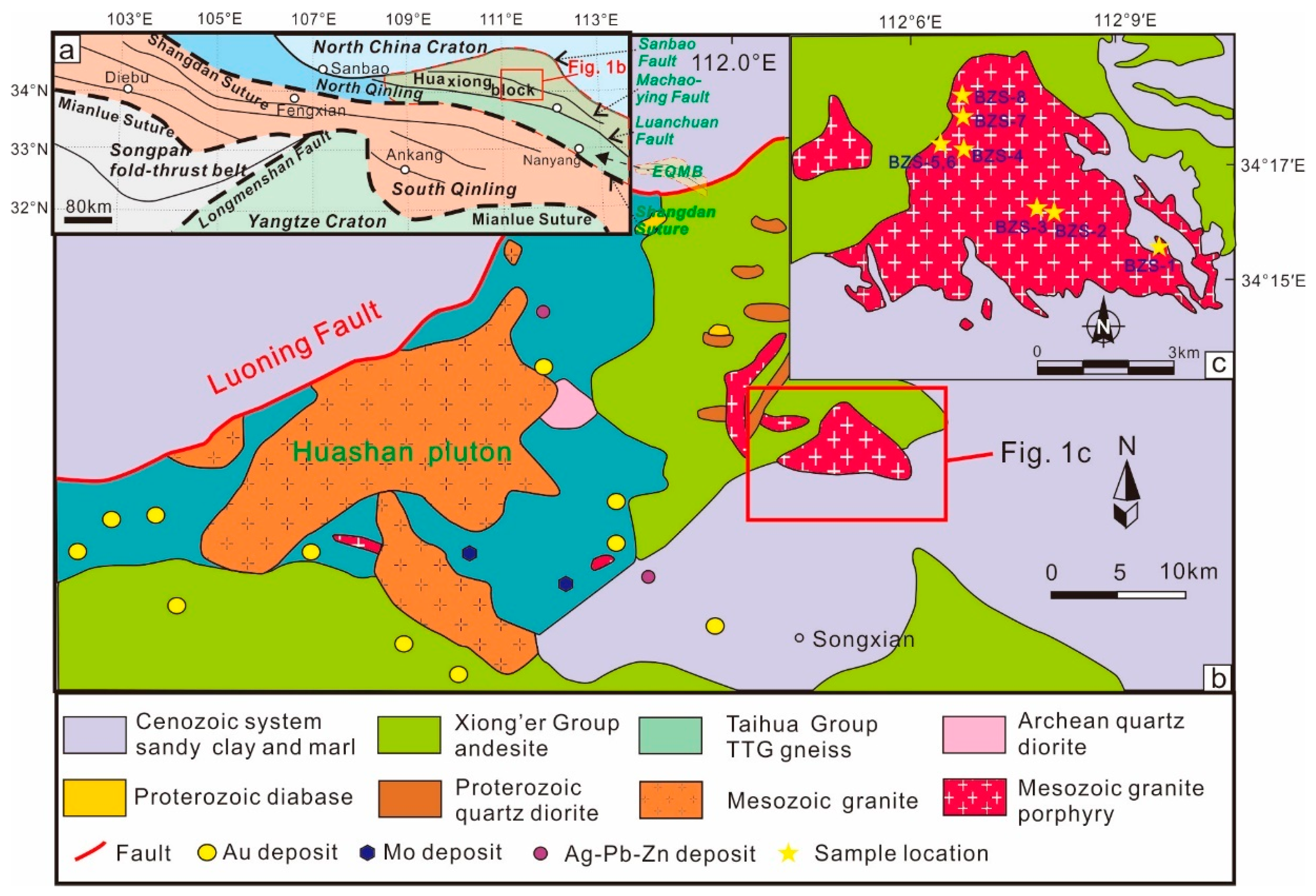
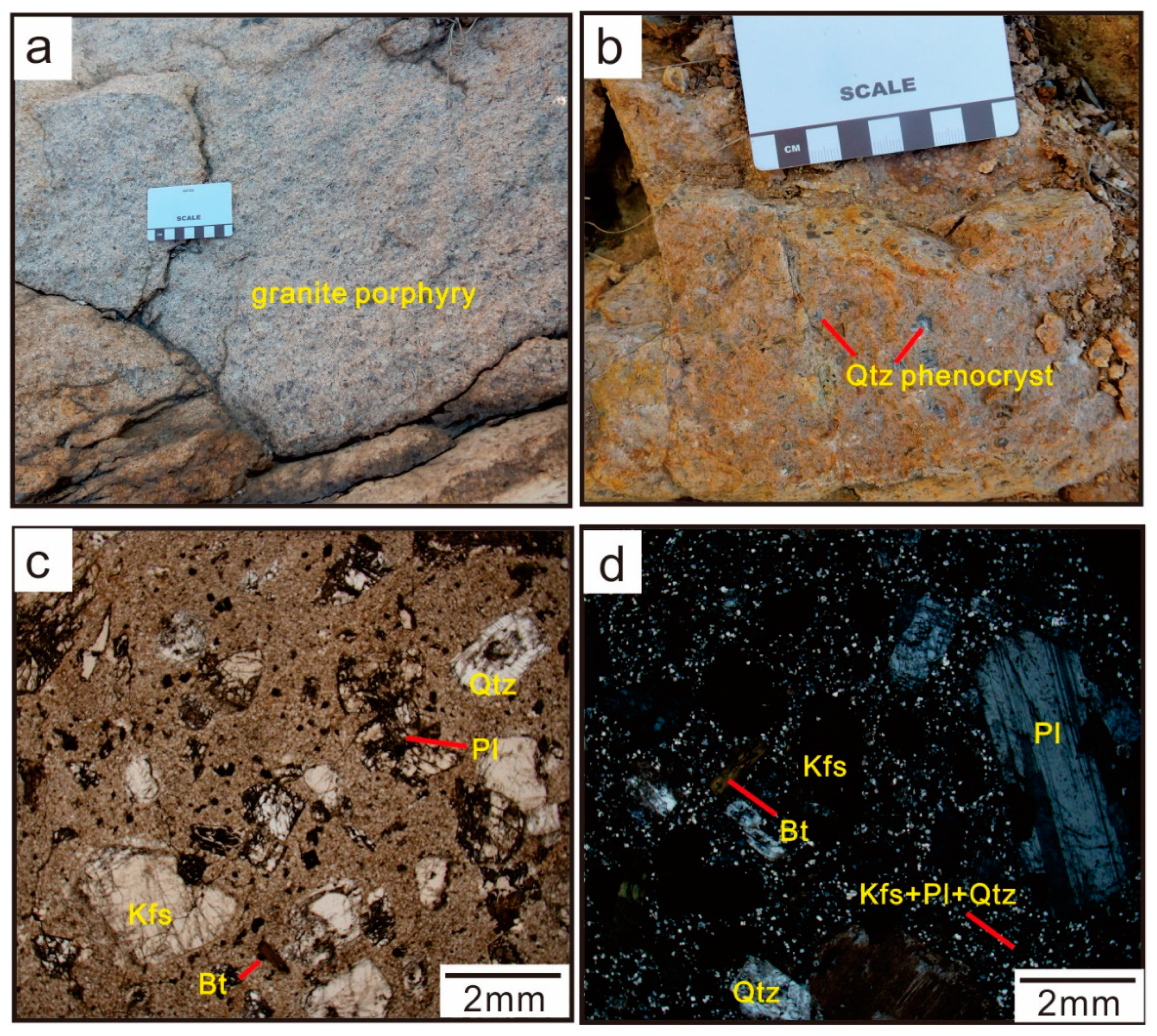
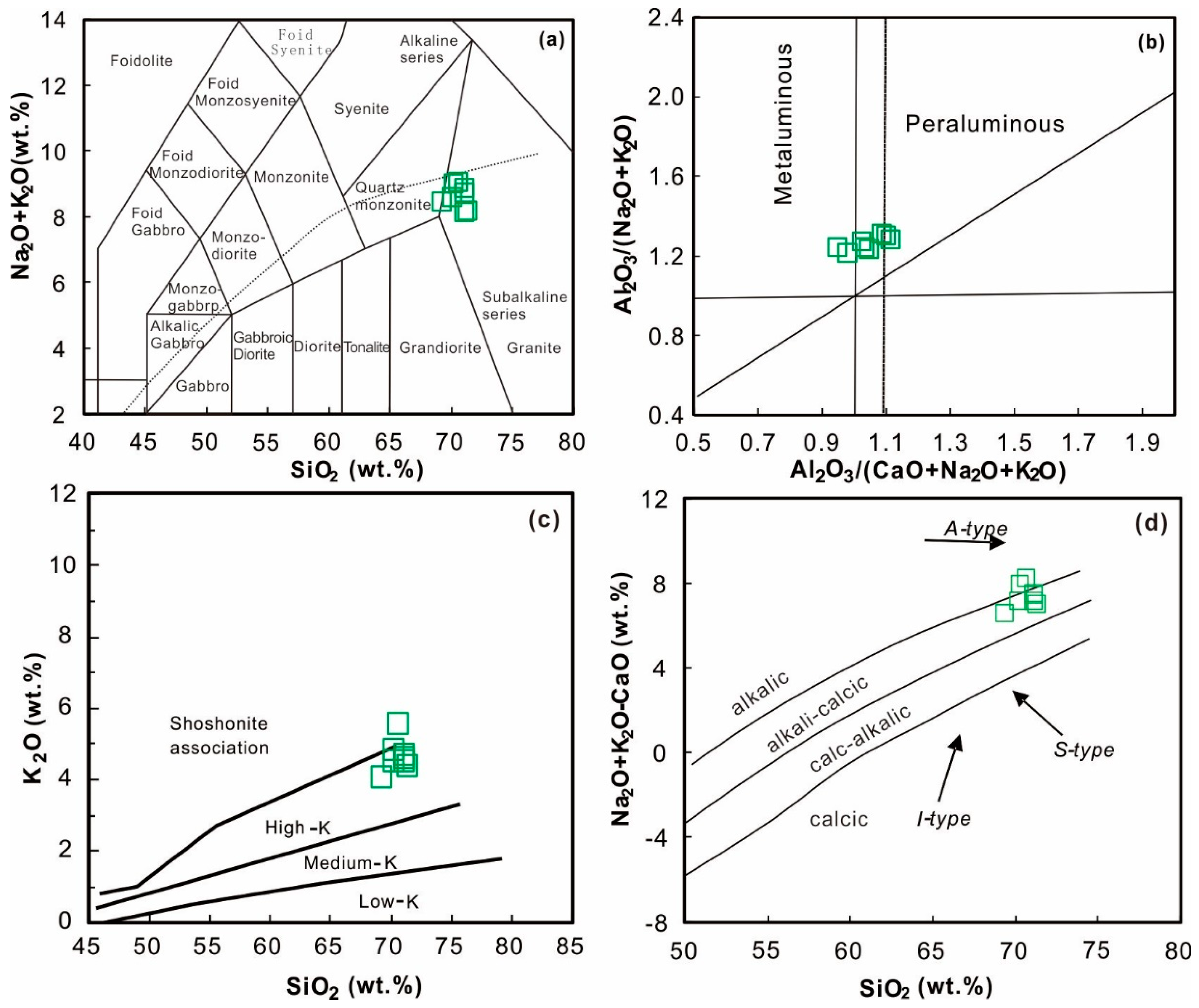
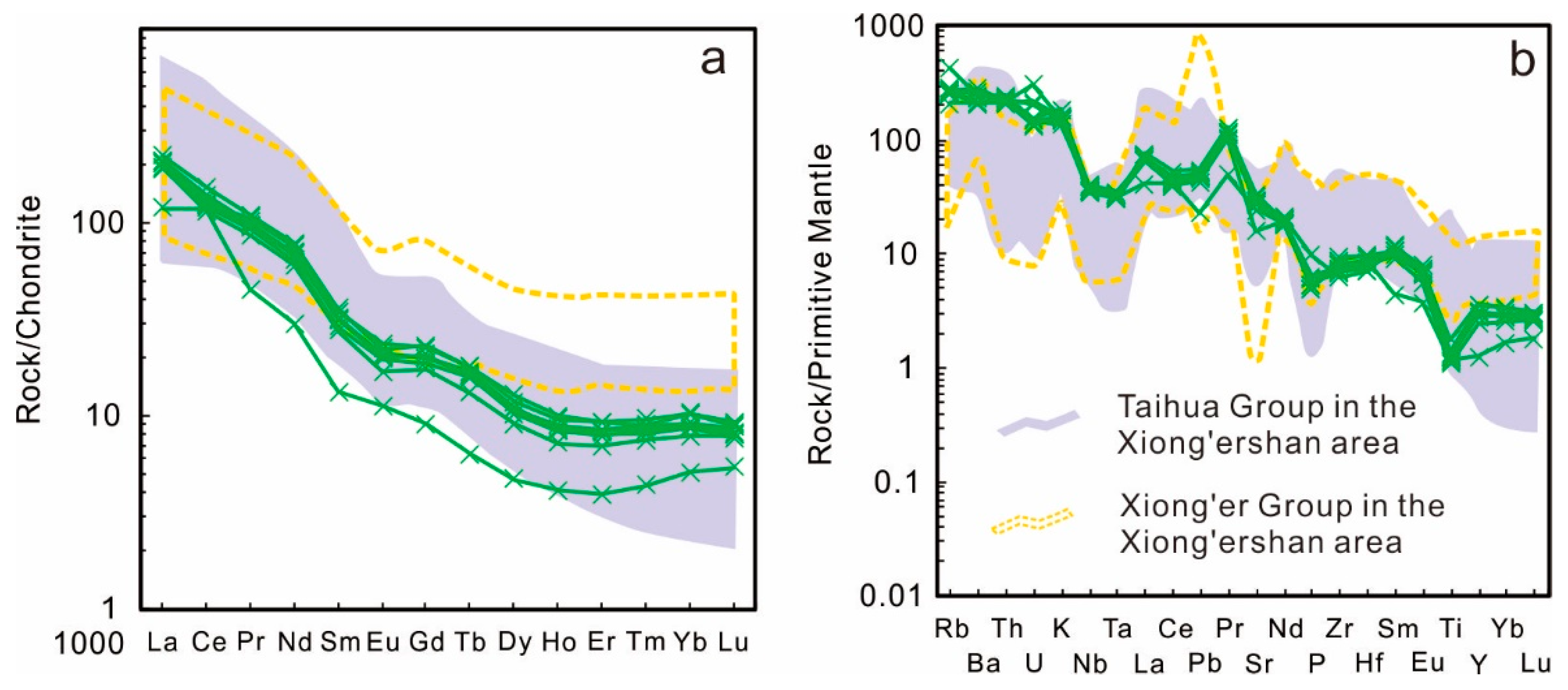
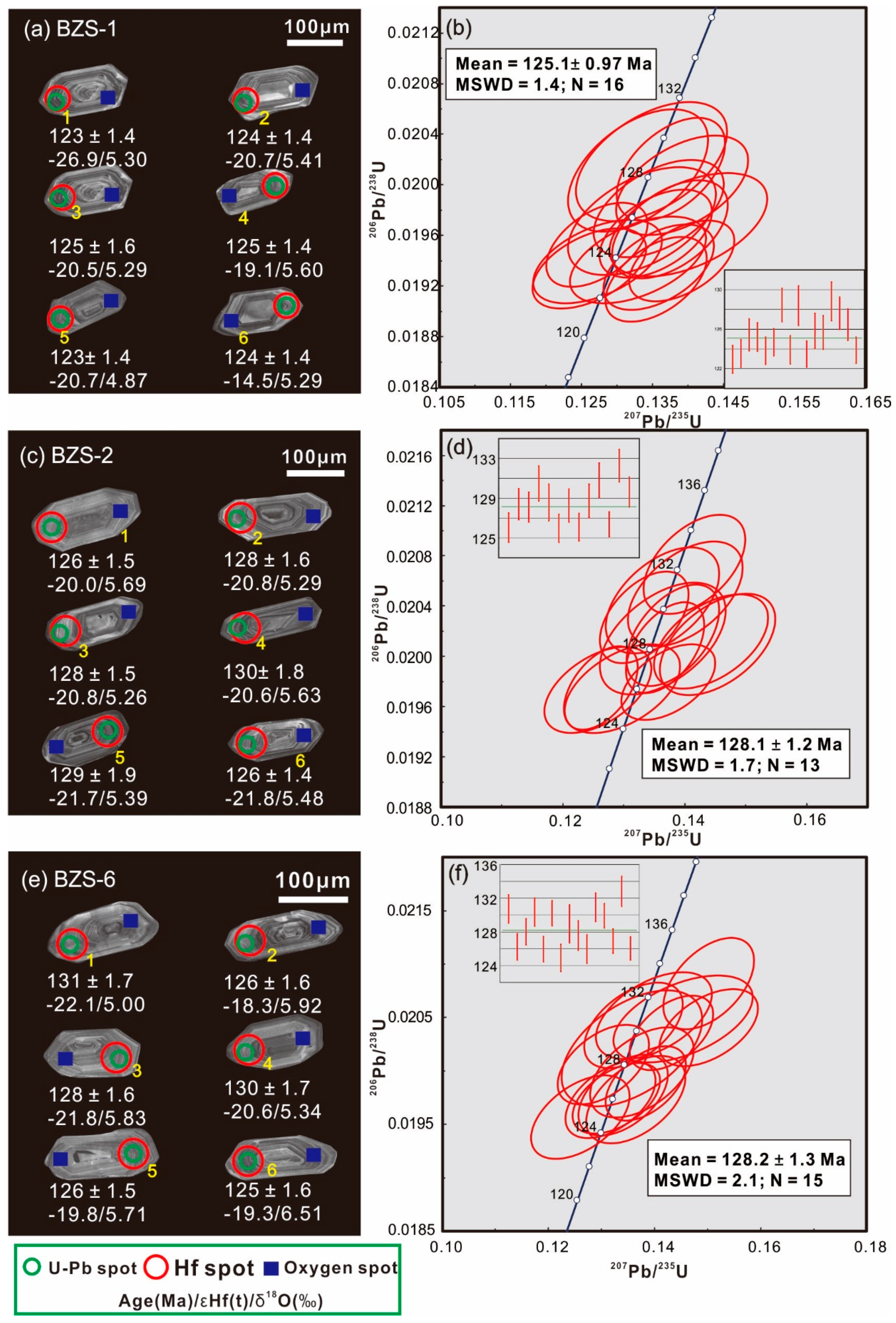
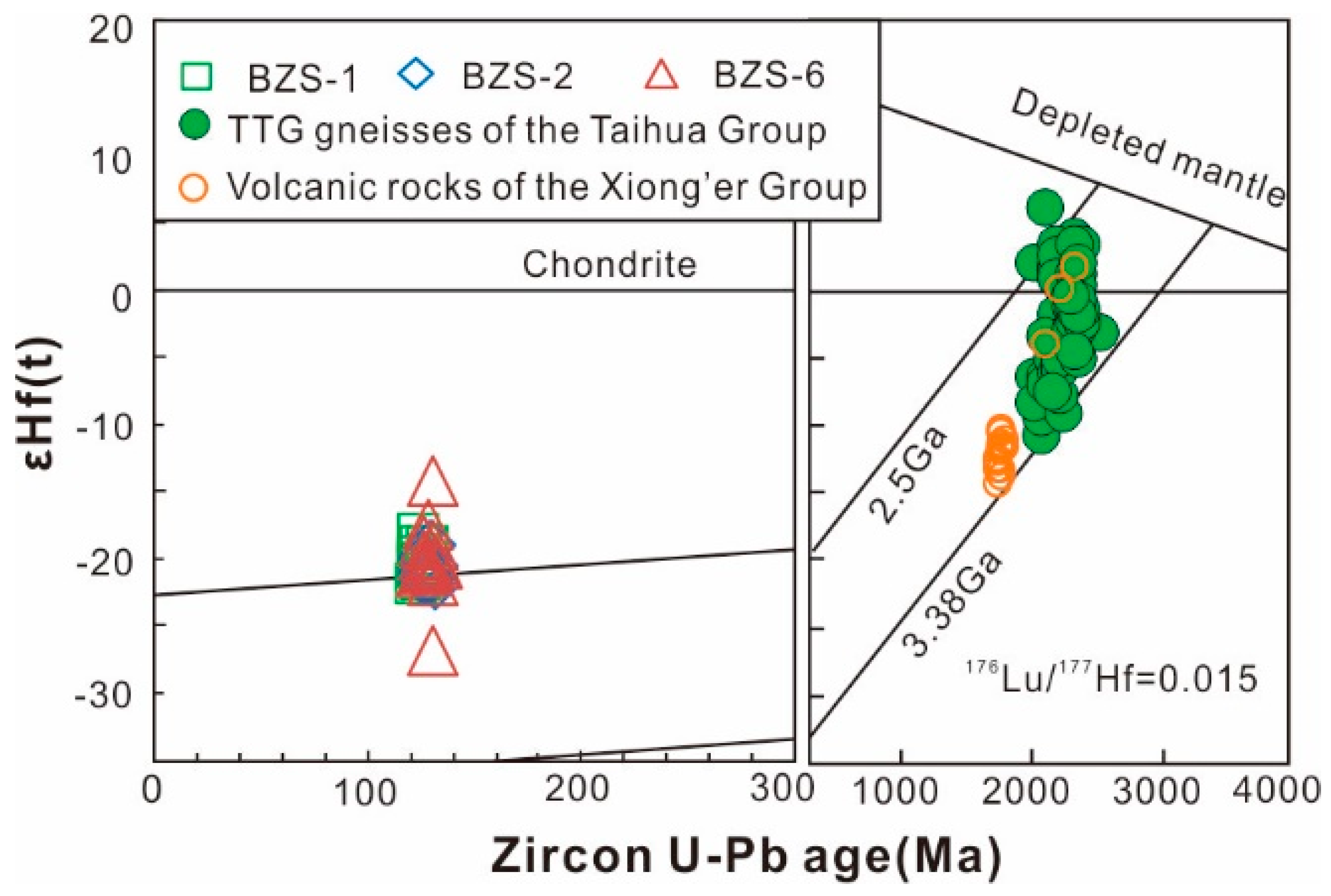
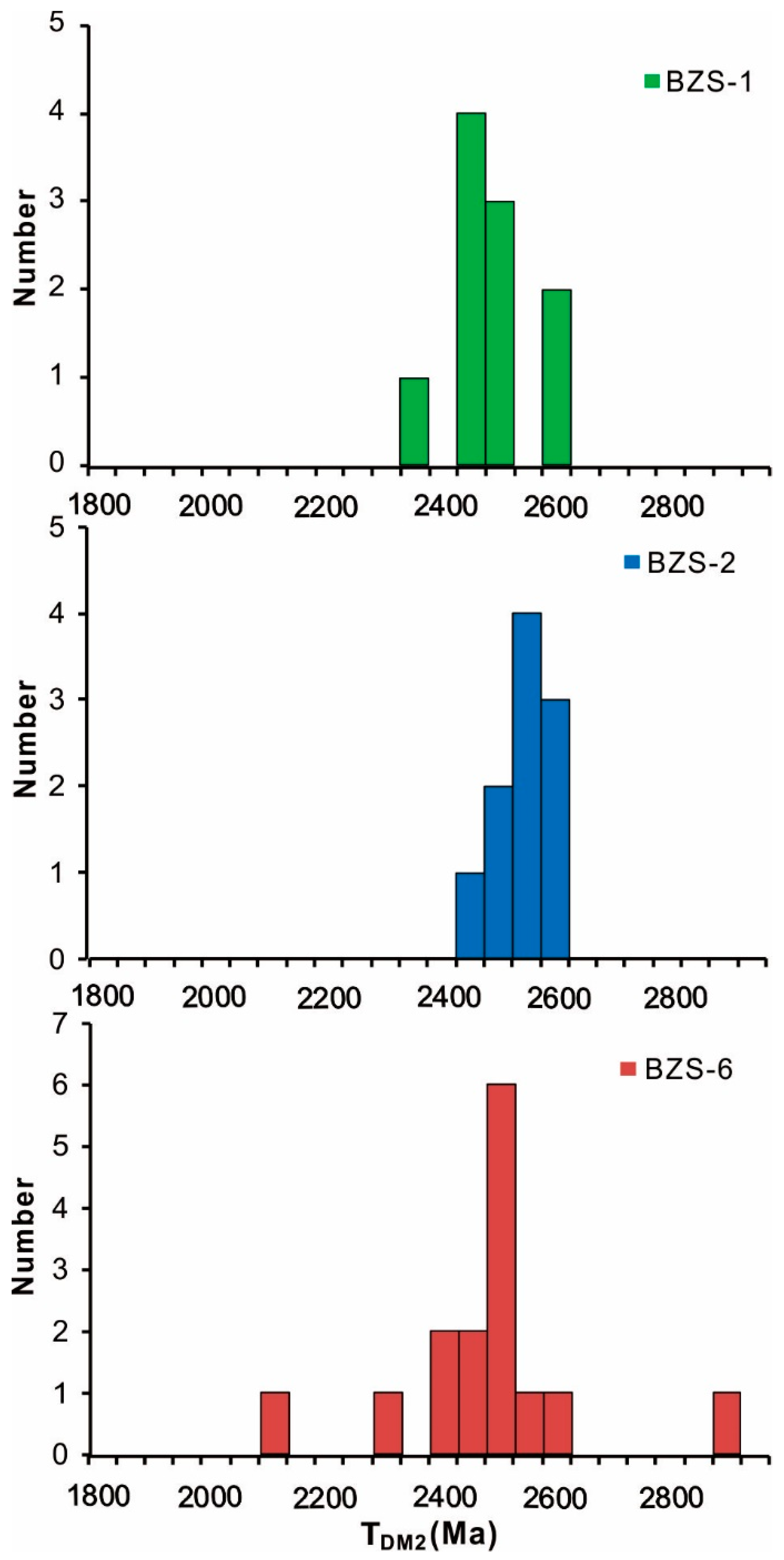
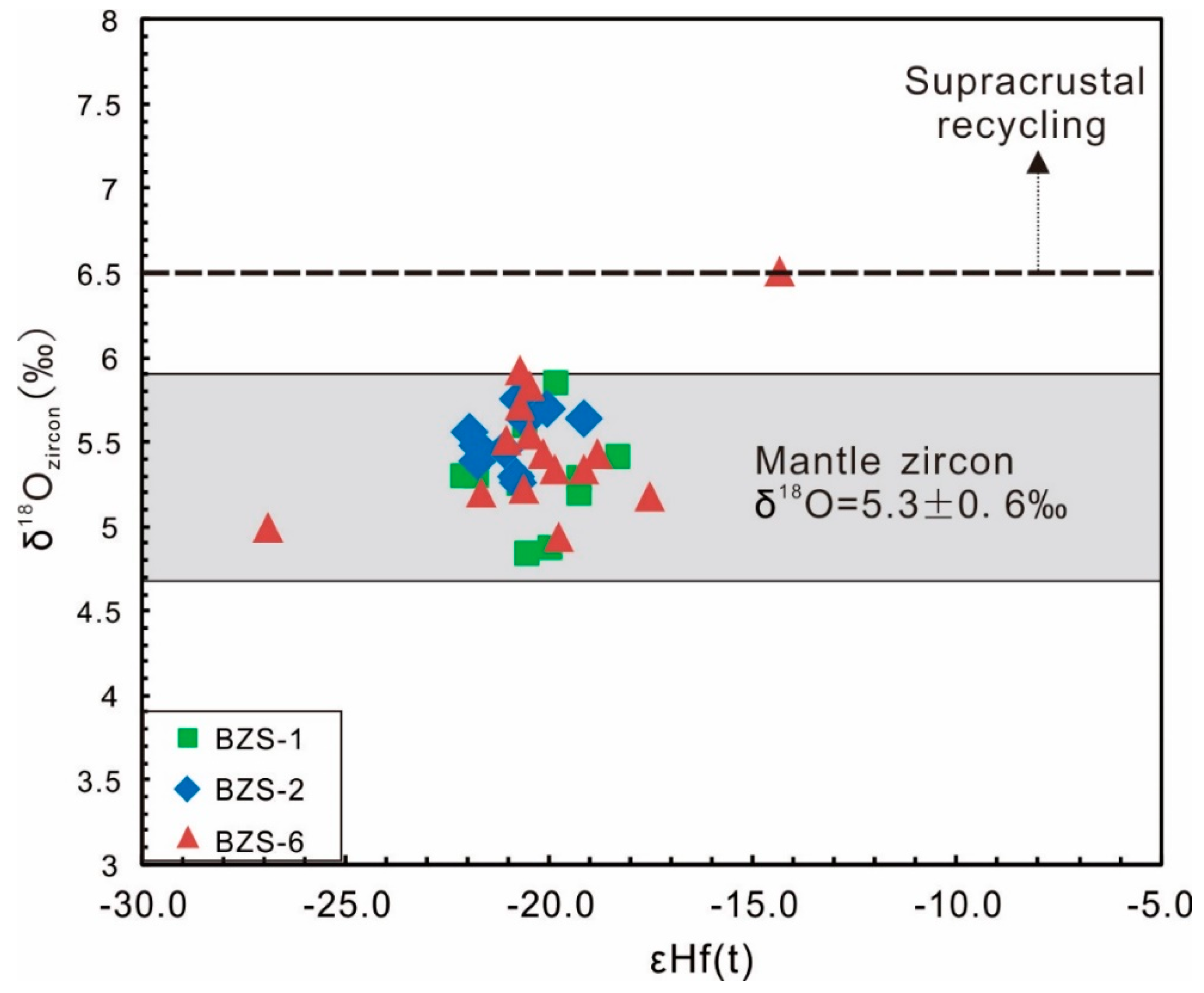
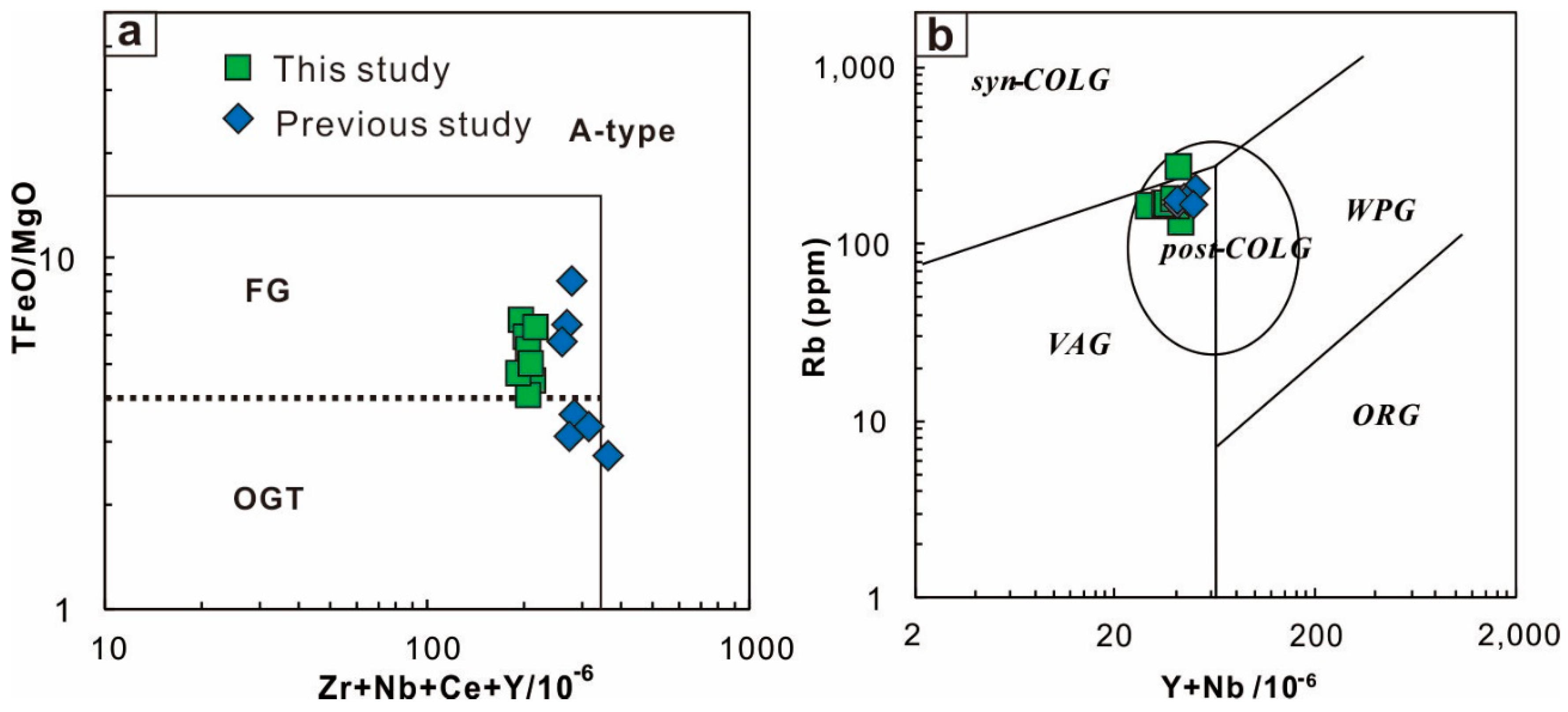
| Analysis Name | BZS-01 | BZS-02 | BZS-03 | BZS-04 | BZS-05 | BZS-06 | BZS-07 | BZS-08 |
|---|---|---|---|---|---|---|---|---|
| wt. % | ||||||||
| SiO2 | 71.3 | 70.2 | 71.1 | 69.2 | 70.2 | 71.1 | 70.6 | 71.1 |
| TiO2 | 0.25 | 0.29 | 0.23 | 0.38 | 0.28 | 0.26 | 0.27 | 0.27 |
| Al2O3 | 14.5 | 15.0 | 14.1 | 14.5 | 14.8 | 14.6 | 15.1 | 14.7 |
| ΣFe2O3 | 1.85 | 2.24 | 2.11 | 3.08 | 2.37 | 2.11 | 1.99 | 2.17 |
| MnO | 0.04 | 0.05 | 0.04 | 0.08 | 0.08 | 0.06 | 0.04 | 0.07 |
| MgO | 0.24 | 0.33 | 0.42 | 0.67 | 0.38 | 0.39 | 0.28 | 0.38 |
| CaO | 1.29 | 1.20 | 1.10 | 2.03 | 1.57 | 1.59 | 0.96 | 1.34 |
| Na2O | 3.79 | 4.18 | 3.63 | 4.37 | 4.08 | 4.18 | 3.49 | 4.13 |
| K2O | 4.41 | 4.87 | 4.54 | 4.11 | 4.54 | 4.72 | 5.61 | 4.65 |
| P2O5 | 0.12 | 0.14 | 0.11 | 0.21 | 0.13 | 0.12 | 0.11 | 0.12 |
| LOI | 1.69 | 1.05 | 2.05 | 0.84 | 1.11 | 0.45 | 1.06 | 0.57 |
| Total | 99.4 | 99.5 | 99.5 | 99.5 | 99.5 | 99.5 | 99.5 | 99.5 |
| K2O/Na2O | 1.16 | 1.17 | 1.25 | 0.94 | 1.11 | 1.13 | 1.61 | 1.13 |
| A/CNK | 1.08 | 1.04 | 1.10 | 0.94 | 1.02 | 0.98 | 1.11 | 1.03 |
| ppm | ||||||||
| Li | 13.4 | 14.4 | 23.1 | 29.9 | 18.7 | 16.9 | 11.2 | 16.5 |
| Be | 3.67 | 3.81 | 3.69 | 3.62 | 3.41 | 3.82 | 3.17 | 3.87 |
| Sc | 2.30 | 2.55 | 2.23 | 3.10 | 2.24 | 2.37 | 2.51 | 2.54 |
| V | 31.4 | 32.4 | 20.7 | 31.4 | 28.9 | 28.7 | 25.3 | 27.1 |
| Cr | 3.53 | 2.48 | 1.77 | 1.63 | 2.04 | 1.96 | 1.61 | 2.69 |
| Co | 2.21 | 2.15 | 2.34 | 3.24 | 2.54 | 2.12 | 2.22 | 2.56 |
| Ni | 2.10 | 1.77 | 2.28 | 2.21 | 2.39 | 1.87 | 2.29 | 2.97 |
| Cu | 5.23 | 3.79 | 4.51 | 4.58 | 5.14 | 3.85 | 3.83 | 3.95 |
| Zn | 43.8 | 43.8 | 34.9 | 51.6 | 64.9 | 55.9 | 41.6 | 41.0 |
| Ga | 21.7 | 22.2 | 18.5 | 23.9 | 21.5 | 23.1 | 24.8 | 25.9 |
| Rb | 163 | 172 | 168 | 131 | 163 | 169 | 267 | 180 |
| Ba | 1422 | 1971 | 1500 | 1460 | 1836 | 1696 | 1654 | 1704 |
| Th | 19.5 | 18.3 | 19.3 | 17.9 | 18.1 | 17.6 | 20.7 | 19.6 |
| U | 4.26 | 2.79 | 3.18 | 3.07 | 6.49 | 4.51 | 3.2 | 2.83 |
| Nb | 24.5 | 25.8 | 25.5 | 27.7 | 27.4 | 24.9 | 28.7 | 26.4 |
| Ta | 1.27 | 1.32 | 1.26 | 1.36 | 1.35 | 1.24 | 1.42 | 1.32 |
| La | 28.2 | 49.3 | 44.8 | 52.6 | 49.4 | 48 | 47.3 | 46 |
| Ce | 72.4 | 77.1 | 69.7 | 92.8 | 84.8 | 74.5 | 76.6 | 80.5 |
| Pb | 4.19 | 9.74 | 7.92 | 10.1 | 9.34 | 8.63 | 8.84 | 8.87 |
| Pr | 13.7 | 34.4 | 27.5 | 35.4 | 32 | 28.9 | 31.1 | 31.6 |
| Sr | 513 | 708 | 335 | 609 | 666 | 615 | 599 | 583 |
| Nd | 24.5 | 25.8 | 25.5 | 27.7 | 27.4 | 24.9 | 28.7 | 26.4 |
| Sm | 1.96 | 5.09 | 4.05 | 5.31 | 4.78 | 4.28 | 4.66 | 4.65 |
| Zr | 91.7 | 82.9 | 105 | 69.2 | 79.4 | 77.3 | 97.4 | 88.7 |
| Hf | 2.61 | 2.54 | 3.01 | 2.18 | 2.22 | 2.45 | 2.92 | 2.77 |
| Eu | 0.63 | 1.32 | 0.95 | 1.25 | 1.15 | 1.11 | 1.13 | 1.18 |
| Gd | 1.79 | 4.45 | 3.46 | 4.55 | 3.94 | 3.75 | 4.11 | 3.97 |
| Tb | 0.23 | 0.65 | 0.47 | 0.65 | 0.61 | 0.57 | 0.56 | 0.59 |
| Dy | 1.15 | 2.88 | 2.22 | 3.14 | 2.7 | 2.51 | 2.65 | 2.65 |
| Y | 5.7 | 15.9 | 11.1 | 16.3 | 14.3 | 12.9 | 13.5 | 13.6 |
| Ho | 0.22 | 0.53 | 0.39 | 0.54 | 0.46 | 0.45 | 0.46 | 0.49 |
| Er | 0.62 | 1.48 | 1.11 | 1.48 | 1.35 | 1.3 | 1.26 | 1.35 |
| Tm | 0.11 | 0.22 | 0.19 | 0.24 | 0.21 | 0.20 | 0.21 | 0.22 |
| Yb | 0.82 | 1.65 | 1.26 | 1.66 | 1.42 | 1.39 | 1.4 | 1.47 |
| Lu | 0.13 | 0.22 | 0.20 | 0.23 | 0.20 | 0.20 | 0.19 | 0.22 |
| (La/Yb)N | 23.3 | 20.3 | 24.2 | 21.5 | 23.6 | 23.5 | 23.0 | 21.3 |
| Sr/Y | 90.0 | 44.5 | 30.2 | 37.4 | 46.6 | 47.7 | 44.4 | 42.9 |
| δEu | 1.01 | 0.83 | 0.76 | 0.76 | 0.78 | 0.83 | 0.77 | 0.82 |
| Analysis Name | Element (ppm) | Th/U | Isotope Ratio | Rho | Apparent Age (Ma) | ||||||||||
|---|---|---|---|---|---|---|---|---|---|---|---|---|---|---|---|
| Pb | Th | U | 207Pb/206Pb | 1σ | 207Pb/235U | 1σ | 206Pb/238U | 1σ | 207Pb/235U | 1σ | 206Pb/238U | 1σ | |||
| BZS-1-01 | 26 | 650 | 1132 | 0.57 | 0.050533 | 0.001859 | 0.135501 | 0.004676 | 0.019254 | 0.000221 | 0.3327 | 129 | 4 | 123 | 1 |
| BZS-1-02 | 17 | 493 | 723 | 0.68 | 0.050386 | 0.001948 | 0.135874 | 0.005104 | 0.019350 | 0.000222 | 0.3052 | 129 | 5 | 124 | 1 |
| BZS-1-03 | 14 | 314 | 578 | 0.54 | 0.050499 | 0.002087 | 0.137420 | 0.005368 | 0.019648 | 0.000256 | 0.3338 | 131 | 5 | 125 | 2 |
| BZS-1-04 | 16 | 292 | 676 | 0.43 | 0.049798 | 0.002024 | 0.135477 | 0.005220 | 0.019614 | 0.000229 | 0.3026 | 129 | 5 | 125 | 1 |
| BZS-1-06 | 18 | 673 | 703 | 0.96 | 0.047251 | 0.002256 | 0.127276 | 0.005998 | 0.019394 | 0.000218 | 0.2387 | 122 | 5 | 124 | 1 |
| BZS-1-07 | 22 | 429 | 959 | 0.45 | 0.046912 | 0.001779 | 0.127151 | 0.004705 | 0.019528 | 0.000219 | 0.3030 | 122 | 4 | 125 | 1 |
| BZS-1-08 | 19 | 468 | 767 | 0.61 | 0.049477 | 0.001863 | 0.137543 | 0.005017 | 0.020126 | 0.000268 | 0.3644 | 131 | 4 | 128 | 2 |
| BZS-1-10 | 12 | 373 | 498 | 0.75 | 0.049749 | 0.002428 | 0.132929 | 0.006298 | 0.019407 | 0.000227 | 0.2463 | 127 | 6 | 124 | 1 |
| BZS-1-11 | 15 | 324 | 647 | 0.50 | 0.048285 | 0.002301 | 0.132957 | 0.006472 | 0.020116 | 0.000319 | 0.3259 | 127 | 6 | 128 | 2 |
| BZS-1-12 | 22 | 807 | 883 | 0.91 | 0.047237 | 0.001985 | 0.126130 | 0.005276 | 0.019340 | 0.000210 | 0.2592 | 121 | 5 | 123 | 1 |
| BZS-1-13 | 13 | 477 | 504 | 0.95 | 0.049692 | 0.002624 | 0.133491 | 0.006855 | 0.019711 | 0.000281 | 0.2778 | 127 | 6 | 126 | 2 |
| BZS-1-14 | 11 | 259 | 478 | 0.54 | 0.051486 | 0.002692 | 0.140042 | 0.007321 | 0.019685 | 0.000269 | 0.2618 | 133 | 7 | 126 | 2 |
| BZS-1-15 | 11 | 316 | 455 | 0.69 | 0.048587 | 0.002513 | 0.134840 | 0.007011 | 0.020183 | 0.000311 | 0.2962 | 128 | 6 | 129 | 2 |
| BZS-1-16 | 17 | 433 | 729 | 0.59 | 0.049802 | 0.002015 | 0.139123 | 0.006124 | 0.019995 | 0.000259 | 0.2940 | 132 | 5 | 128 | 2 |
| BZS-1-18 | 16 | 402 | 688 | 0.58 | 0.049690 | 0.002216 | 0.135845 | 0.006020 | 0.019812 | 0.000253 | 0.2883 | 129 | 5 | 126 | 2 |
| BZS-1-19 | 22 | 573 | 947 | 0.60 | 0.051585 | 0.001770 | 0.139085 | 0.004888 | 0.019401 | 0.000211 | 0.3096 | 132 | 4 | 124 | 1 |
| BZS-2-01 | 12 | 226 | 497 | 0.46 | 0.047591 | 0.002391 | 0.129769 | 0.006234 | 0.019744 | 0.000235 | 0.2472 | 124 | 6 | 126 | 1 |
| BZS-2-02 | 15 | 357 | 596 | 0.60 | 0.052107 | 0.002336 | 0.144321 | 0.006185 | 0.020117 | 0.000247 | 0.2870 | 137 | 5 | 128 | 2 |
| BZS-2-03 | 25 | 568 | 1032 | 0.55 | 0.049176 | 0.001552 | 0.136777 | 0.004231 | 0.020069 | 0.000238 | 0.3835 | 130 | 4 | 128 | 2 |
| BZS-2-05 | 17 | 405 | 691 | 0.59 | 0.048143 | 0.002172 | 0.136341 | 0.006135 | 0.020446 | 0.000279 | 0.3038 | 130 | 5 | 130 | 2 |
| BZS-2-06 | 11 | 348 | 441 | 0.79 | 0.049214 | 0.002511 | 0.136390 | 0.006839 | 0.020143 | 0.000294 | 0.2907 | 130 | 6 | 129 | 2 |
| BZS-2-10 | 12 | 249 | 532 | 0.47 | 0.046656 | 0.002225 | 0.125731 | 0.005767 | 0.019733 | 0.000226 | 0.2498 | 120 | 5 | 126 | 1 |
| BZS-2-11 | 14 | 283 | 578 | 0.49 | 0.052784 | 0.002259 | 0.145380 | 0.006270 | 0.020094 | 0.000265 | 0.3058 | 138 | 6 | 128 | 2 |
| BZS-2-13 | 22 | 578 | 944 | 0.61 | 0.046494 | 0.001507 | 0.126262 | 0.003994 | 0.019751 | 0.000219 | 0.3512 | 121 | 4 | 126 | 1 |
| BZS-2-14 | 23 | 600 | 967 | 0.62 | 0.049827 | 0.001829 | 0.138044 | 0.004984 | 0.020168 | 0.000267 | 0.3666 | 131 | 4 | 129 | 2 |
| BZS-2-15 | 11 | 256 | 455 | 0.56 | 0.049365 | 0.002183 | 0.140035 | 0.006208 | 0.020499 | 0.000274 | 0.3010 | 133 | 6 | 131 | 2 |
| BZS-2-18 | 22 | 626 | 891 | 0.70 | 0.050085 | 0.001867 | 0.137304 | 0.005095 | 0.019796 | 0.000198 | 0.2694 | 131 | 5 | 126 | 1 |
| BZS-2-19 | 23 | 507 | 967 | 0.52 | 0.048989 | 0.001794 | 0.141548 | 0.005514 | 0.020731 | 0.000260 | 0.3225 | 134 | 5 | 132 | 2 |
| BZS-2-20 | 28 | 1073 | 1047 | 1.03 | 0.047255 | 0.001681 | 0.133325 | 0.004784 | 0.020310 | 0.000240 | 0.3288 | 127 | 4 | 130 | 2 |
| BZS-6-01 | 15 | 377 | 611 | 0.62 | 0.051403 | 0.003105 | 0.145402 | 0.008640 | 0.020488 | 0.000267 | 0.2192 | 138 | 8 | 131 | 2 |
| BZS-6-02 | 16 | 476 | 676 | 0.70 | 0.048784 | 0.001994 | 0.134077 | 0.005534 | 0.019774 | 0.000248 | 0.3039 | 128 | 5 | 126 | 2 |
| BZS-6-03 | 15 | 327 | 618 | 0.53 | 0.046871 | 0.002094 | 0.130383 | 0.005702 | 0.020059 | 0.000246 | 0.2801 | 124 | 5 | 128 | 2 |
| BZS-6-04 | 14 | 316 | 585 | 0.54 | 0.047832 | 0.002089 | 0.136039 | 0.006158 | 0.020425 | 0.000264 | 0.2853 | 130 | 6 | 130 | 2 |
| BZS-6-05 | 18 | 376 | 790 | 0.48 | 0.048442 | 0.002439 | 0.131713 | 0.005615 | 0.019732 | 0.000238 | 0.2830 | 126 | 5 | 126 | 2 |
| BZS-6-07 | 20 | 835 | 729 | 1.15 | 0.053378 | 0.002300 | 0.150217 | 0.006112 | 0.020405 | 0.000237 | 0.2856 | 142 | 5 | 130 | 1 |
| BZS-6-08 | 11 | 250 | 469 | 0.53 | 0.046894 | 0.002371 | 0.125993 | 0.006130 | 0.019566 | 0.000258 | 0.2710 | 120 | 6 | 125 | 2 |
| BZS-6-09 | 5 | 173 | 200 | 0.86 | 0.048417 | 0.003286 | 0.135670 | 0.008745 | 0.020209 | 0.000358 | 0.2752 | 129 | 8 | 129 | 2 |
| BZS-6-10 | 9 | 211 | 380 | 0.55 | 0.049978 | 0.002451 | 0.137623 | 0.006430 | 0.019987 | 0.000278 | 0.2976 | 131 | 6 | 128 | 2 |
| BZS-6-11 | 13 | 221 | 584 | 0.38 | 0.049855 | 0.002217 | 0.136493 | 0.006184 | 0.019732 | 0.000270 | 0.3016 | 130 | 6 | 126 | 2 |
| BZS-6-13 | 9 | 173 | 381 | 0.45 | 0.049881 | 0.002867 | 0.139870 | 0.007189 | 0.020517 | 0.000268 | 0.2546 | 133 | 6 | 131 | 2 |
| BZS-6-14 | 24 | 515 | 1012 | 0.51 | 0.050560 | 0.001887 | 0.143187 | 0.005196 | 0.020358 | 0.000230 | 0.3118 | 136 | 5 | 130 | 1 |
| BZS-6-15 | 31 | 839 | 1316 | 0.64 | 0.050143 | 0.001870 | 0.138370 | 0.005008 | 0.019884 | 0.000228 | 0.3172 | 132 | 4 | 127 | 1 |
| BZS-6-18 | 13 | 230 | 586 | 0.39 | 0.052214 | 0.002024 | 0.150191 | 0.005637 | 0.020816 | 0.000283 | 0.3617 | 142 | 5 | 133 | 2 |
| BZS-6-20 | 15 | 325 | 649 | 0.50 | 0.048463 | 0.002006 | 0.132816 | 0.005431 | 0.019744 | 0.000218 | 0.2706 | 127 | 5 | 126 | 1 |
| Analysis Name | Age (Ma) | 176Yb/177Hf | 1σ | 176Lu/177Hf | 1σ | 176Hf/177Hf | 1σ | (176Hf/177Hf)i | εHf(0) | εHf(t) | TDM1 (Ma) | TDM2 (Ma) | fLu/Hf |
|---|---|---|---|---|---|---|---|---|---|---|---|---|---|
| BZS-1-01 | 123 | 0.028260 | 0.000420 | 0.001024 | 0.000020 | 0.282074 | 0.000042 | 0.282072 | −24.68 | −22.08 | 1661 | 2580 | −0.97 |
| BZS-1-02 | 124 | 0.039650 | 0.000750 | 0.001509 | 0.000064 | 0.282182 | 0.000080 | 0.282179 | −20.86 | −18.28 | 1530 | 2341 | −0.95 |
| BZS-1-03 | 125 | 0.036180 | 0.000680 | 0.001283 | 0.000022 | 0.282082 | 0.000035 | 0.282079 | −24.40 | −21.76 | 1661 | 2562 | −0.96 |
| BZS-1-04 | 125 | 0.026860 | 0.000250 | 0.000979 | 0.000006 | 0.282115 | 0.000037 | 0.282113 | −23.23 | −20.58 | 1602 | 2487 | −0.97 |
| BZS-1-06 | 124 | 0.037200 | 0.001300 | 0.001352 | 0.000063 | 0.282134 | 0.000051 | 0.282131 | −22.56 | −19.96 | 1591 | 2447 | −0.96 |
| BZS-1-07 | 125 | 0.030820 | 0.000700 | 0.001130 | 0.000036 | 0.282153 | 0.000046 | 0.282150 | −21.89 | −19.26 | 1555 | 2404 | −0.97 |
| BZS-1-08 | 128 | 0.037810 | 0.000360 | 0.001344 | 0.000015 | 0.282136 | 0.000037 | 0.282133 | −22.49 | −19.80 | 1588 | 2440 | −0.96 |
| BZS-1-10 | 124 | 0.032400 | 0.001300 | 0.001037 | 0.000029 | 0.282112 | 0.000042 | 0.282110 | −23.34 | −20.71 | 1609 | 2495 | −0.97 |
| BZS-1-11 | 128 | 0.042290 | 0.000650 | 0.001538 | 0.000029 | 0.282152 | 0.000035 | 0.282148 | −21.93 | −19.25 | 1574 | 2405 | −0.95 |
| BZS-1-12 | 123 | 0.031900 | 0.001500 | 0.001236 | 0.000045 | 0.282118 | 0.000041 | 0.282115 | −23.13 | −20.53 | 1609 | 2483 | −0.96 |
| BZS-2-01 | 126 | 0.030070 | 0.000940 | 0.001093 | 0.000038 | 0.282130 | 0.000045 | 0.282127 | −22.70 | −20.04 | 1586 | 2454 | −0.97 |
| BZS-2-02 | 128 | 0.028100 | 0.001000 | 0.001030 | 0.000042 | 0.282106 | 0.000030 | 0.282104 | −23.55 | −20.83 | 1617 | 2505 | −0.97 |
| BZS-2-03 | 128 | 0.037110 | 0.000900 | 0.001329 | 0.000024 | 0.282109 | 0.000045 | 0.282106 | −23.45 | −20.76 | 1625 | 2500 | −0.96 |
| BZS-2-05 | 130 | 0.028900 | 0.002000 | 0.001117 | 0.000094 | 0.282112 | 0.000046 | 0.282109 | −23.34 | −20.58 | 1612 | 2491 | −0.97 |
| BZS-2-06 | 129 | 0.038480 | 0.000830 | 0.001476 | 0.000046 | 0.282081 | 0.000035 | 0.282077 | −24.44 | −21.75 | 1671 | 2563 | −0.96 |
| BZS-2-10 | 126 | 0.040800 | 0.002100 | 0.001448 | 0.000070 | 0.282082 | 0.000033 | 0.282079 | −24.40 | −21.77 | 1669 | 2562 | −0.96 |
| BZS-2-11 | 128 | 0.033970 | 0.000630 | 0.001295 | 0.000035 | 0.282108 | 0.000039 | 0.282105 | −23.48 | −20.79 | 1625 | 2502 | −0.96 |
| BZS-2-13 | 126 | 0.034670 | 0.000910 | 0.001351 | 0.000051 | 0.282100 | 0.000041 | 0.282097 | −23.76 | −21.12 | 1639 | 2522 | −0.96 |
| BZS-2-14 | 129 | 0.033890 | 0.000280 | 0.001410 | 0.000017 | 0.282154 | 0.000038 | 0.282151 | −21.86 | −19.16 | 1566 | 2400 | −0.96 |
| BZS-2-15 | 131 | 0.028660 | 0.000570 | 0.001100 | 0.000025 | 0.282073 | 0.000030 | 0.282070 | −24.72 | −21.95 | 1666 | 2578 | −0.97 |
| BZS-6-01 | 131 | 0.022700 | 0.000410 | 0.000699 | 0.000010 | 0.281932 | 0.000045 | 0.281930 | −29.71 | −26.91 | 1842 | 2889 | −0.98 |
| BZS-6-02 | 126 | 0.031930 | 0.000860 | 0.001156 | 0.000053 | 0.282111 | 0.000030 | 0.282108 | −23.38 | −20.71 | 1615 | 2496 | −0.97 |
| BZS-6-03 | 128 | 0.028690 | 0.000790 | 0.001032 | 0.000025 | 0.282116 | 0.000042 | 0.282114 | −23.20 | −20.49 | 1603 | 2483 | −0.97 |
| BZS-6-04 | 130 | 0.040900 | 0.002200 | 0.001490 | 0.000120 | 0.282154 | 0.000035 | 0.282150 | −21.86 | −19.13 | 1569 | 2400 | −0.96 |
| BZS-6-05 | 126 | 0.032460 | 0.000510 | 0.001135 | 0.000018 | 0.282111 | 0.000029 | 0.282108 | −23.38 | −20.71 | 1614 | 2496 | −0.97 |
| BZS-6-07 | 130 | 0.034600 | 0.001100 | 0.001042 | 0.000057 | 0.282288 | 0.000027 | 0.282285 | −17.12 | −14.36 | 1363 | 2099 | −0.97 |
| BZS-6-08 | 125 | 0.036800 | 0.001100 | 0.001368 | 0.000020 | 0.282103 | 0.000046 | 0.282100 | −23.66 | −21.04 | 1636 | 2516 | −0.96 |
| BZS-6-09 | 129 | 0.033890 | 0.000740 | 0.001165 | 0.000022 | 0.282136 | 0.000049 | 0.282133 | −22.49 | −19.77 | 1581 | 2439 | −0.96 |
| BZS-6-10 | 128 | 0.031100 | 0.002100 | 0.001224 | 0.000088 | 0.282200 | 0.000130 | 0.282197 | −20.23 | −17.54 | 1493 | 2298 | −0.96 |
| BZS-6-11 | 126 | 0.033600 | 0.002500 | 0.001230 | 0.000076 | 0.282135 | 0.000036 | 0.282132 | −22.53 | −19.87 | 1585 | 2443 | −0.96 |
| BZS-6-13 | 131 | 0.028900 | 0.001700 | 0.001035 | 0.000052 | 0.282124 | 0.000055 | 0.282121 | −22.92 | −20.14 | 1592 | 2464 | −0.97 |
| BZS-6-14 | 130 | 0.029170 | 0.000950 | 0.001041 | 0.000042 | 0.282081 | 0.000042 | 0.282078 | −24.44 | −21.68 | 1652 | 2560 | −0.97 |
| BZS-6-15 | 127 | 0.022900 | 0.000410 | 0.000795 | 0.000013 | 0.282112 | 0.000040 | 0.282110 | −23.34 | −20.63 | 1599 | 2492 | −0.98 |
| BZS-6-18 | 133 | 0.035560 | 0.000910 | 0.001204 | 0.000032 | 0.282114 | 0.000033 | 0.282111 | −23.27 | −20.47 | 1613 | 2486 | −0.96 |
| BZS-6-20 | 126 | 0.032300 | 0.001100 | 0.001163 | 0.000032 | 0.282164 | 0.000045 | 0.282161 | −21.50 | −18.84 | 1541 | 2378 | −0.96 |
| Analysis Name | Raw data | Drift Corrected | SIMS Corrected Ratios | δ18Ozircon | 2σ | |||
|---|---|---|---|---|---|---|---|---|
| 18O/16O | 1σ Initial in Relative (%) | 18O/16O | 1σ | 18/16O | 1σ | |||
| BZS-1-01 | 2.02 × 10−3 | 1.11 × 10−2 | 2.02 × 10−3 | 2.24 × 10−7 | 2.02 × 10−3 | 3.71 × 10−7 | 5.30 | 0.37 |
| BZS-1-02 | 2.02 × 10−3 | 1.23 × 10−2 | 2.02 × 10−3 | 2.48 × 10−7 | 2.02 × 10−3 | 3.87 × 10−7 | 5.41 | 0.39 |
| BZS-1-03 | 2.02 × 10−3 | 1.18 × 10−2 | 2.02 × 10−3 | 2.38 × 10−7 | 2.02 × 10−3 | 3.80 × 10−7 | 5.29 | 0.38 |
| BZS-1-04 | 2.02 × 10−3 | 7.51 × 10−3 | 2.02 × 10−3 | 1.52 × 10−7 | 2.02 × 10−3 | 3.33 × 10−7 | 5.60 | 0.33 |
| BZS-1-05 | 2.02 × 10−3 | 9.52 × 10−3 | 2.02 × 10−3 | 1.92 × 10−7 | 2.02 × 10−3 | 3.53 × 10−7 | 4.87 | 0.35 |
| BZS-1-06 | 2.02 × 10−3 | 1.04 × 10−2 | 2.02 × 10−3 | 2.10 × 10−7 | 2.02 × 10−3 | 3.63 × 10−7 | 5.29 | 0.36 |
| BZS-1-07 | 2.02 × 10−3 | 9.64 × 10−3 | 2.02 × 10−3 | 1.95 × 10−7 | 2.02 × 10−3 | 3.55 × 10−7 | 5.85 | 0.35 |
| BZS-1-08 | 2.02 × 10−3 | 1.50 × 10−2 | 2.02 × 10−3 | 3.03 × 10−7 | 2.02 × 10−3 | 4.24 × 10−7 | 5.25 | 0.42 |
| BZS-1-09 | 2.02 × 10−3 | 1.06 × 10−2 | 2.02 × 10−3 | 2.14 × 10−7 | 2.02 × 10−3 | 3.65 × 10−7 | 5.19 | 0.36 |
| BZS-1-10 | 2.02 × 10−3 | 1.15 × 10−2 | 2.02 × 10−3 | 2.32 × 10−7 | 2.02 × 10−3 | 3.76 × 10−7 | 4.84 | 0.38 |
| BZS-1-11 | 2.02 × 10−3 | 1.39 × 10−2 | 2.02 × 10−3 | 2.80 × 10−7 | 2.02 × 10−3 | 4.07 × 10−7 | 5.55 | 0.41 |
| BZS-2-01 | 2.02 × 10−3 | 6.77 × 10−3 | 2.02 × 10−3 | 1.37 × 10−7 | 2.02 × 10−3 | 3.26 × 10−7 | 5.69 | 0.33 |
| BZS-2-02 | 2.02 × 10−3 | 6.87 × 10−3 | 2.02 × 10−3 | 1.39 × 10−7 | 2.02 × 10−3 | 3.27 × 10−7 | 5.29 | 0.33 |
| BZS-2-03 | 2.02 × 10−3 | 1.23 × 10−2 | 2.02 × 10−3 | 2.47 × 10−7 | 2.02 × 10−3 | 3.86 × 10−7 | 5.26 | 0.38 |
| BZS-2-04 | 2.02 × 10−3 | 1.79 × 10−2 | 2.02 × 10−3 | 3.61 × 10−7 | 2.02 × 10−3 | 4.67 × 10−7 | 5.63 | 0.47 |
| BZS-2-05 | 2.02 × 10−3 | 1.29 × 10−2 | 2.02 × 10−3 | 2.60 × 10−7 | 2.02 × 10−3 | 3.94 × 10−7 | 5.39 | 0.39 |
| BZS-2-06 | 2.02 × 10−3 | 6.74 × 10−3 | 2.02 × 10−3 | 1.36 × 10−7 | 2.02 × 10−3 | 3.26 × 10−7 | 5.48 | 0.33 |
| BZS-2-07 | 2.02 × 10−3 | 9.23 × 10−3 | 2.02 × 10−3 | 1.86 × 10−7 | 2.02 × 10−3 | 3.50 × 10−7 | 5.75 | 0.35 |
| BZS-2-08 | 2.02 × 10−3 | 6.72 × 10−3 | 2.02 × 10−3 | 1.36 × 10−7 | 2.02 × 10−3 | 3.26 × 10−7 | 5.46 | 0.32 |
| BZS-2-09 | 2.02 × 10−3 | 1.30 × 10−2 | 2.02 × 10−3 | 2.63 × 10−7 | 2.02 × 10−3 | 3.96 × 10−7 | 5.63 | 0.40 |
| BZS-2-10 | 2.02 × 10−3 | 7.79 × 10−3 | 2.02 × 10−3 | 1.57 × 10−7 | 2.02 × 10−3 | 3.35 × 10-7 | 5.55 | 0.33 |
| BZS-6-01 | 2.02 × 10−3 | 9.58 × 10−3 | 2.02 × 10−3 | 1.93 × 10−7 | 2.02 × 10−3 | 3.54 × 10−7 | 5.00 | 0.35 |
| BZS-6-02 | 2.02 × 10−3 | 1.09 × 10−2 | 2.02 × 10−3 | 2.21 × 10−7 | 2.02 × 10−3 | 3.70 × 10−7 | 5.92 | 0.37 |
| BZS-6-03 | 2.02 × 10−3 | 1.05 × 10−2 | 2.02 × 10−3 | 2.11 × 10−7 | 2.02 × 10−3 | 3.64 × 10−7 | 5.83 | 0.36 |
| BZS-6-04 | 2.02 × 10−3 | 9.24 × 10−3 | 2.02 × 10−3 | 1.86 × 10−7 | 2.02 × 10−3 | 3.50 × 10−7 | 5.34 | 0.35 |
| BZS-6-05 | 2.02 × 10−3 | 8.34 × 10−3 | 2.02 × 10−3 | 1.68 × 10−7 | 2.02 × 10−3 | 3.41 × 10−7 | 5.71 | 0.34 |
| BZS-6-06 | 2.02 × 10−3 | 1.07 × 10−2 | 2.02 × 10−3 | 2.16 × 10−7 | 2.02 × 10−3 | 3.67 × 10−7 | 6.51 | 0.37 |
| BZS-6-07 | 2.02 × 10−3 | 7.53 × 10−3 | 2.02 × 10−3 | 1.52 × 10−7 | 2.02 × 10−3 | 3.33 × 10−7 | 5.51 | 0.33 |
| BZS-6-08 | 2.02 × 10−3 | 8.72 × 10−3 | 2.02 × 10−3 | 1.76 × 10−7 | 2.02 × 10−3 | 3.44 × 10−7 | 4.94 | 0.34 |
| BZS-6-09 | 2.02 × 10−3 | 1.10 × 10−2 | 2.02 × 10−3 | 2.22 × 10-7 | 2.02 × 10−3 | 3.70 × 10−7 | 5.17 | 0.37 |
| BZS-6-10 | 2.02 × 10−3 | 1.06 × 10−2 | 2.02 × 10−3 | 2.13 × 10-7 | 2.02 × 10−3 | 3.65 × 10−7 | 5.35 | 0.36 |
| BZS-6-11 | 2.02 × 10−3 | 1.26 × 10−2 | 2.02 × 10−3 | 2.54 × 10-7 | 2.02 × 10−3 | 3.90 × 10−7 | 5.43 | 0.39 |
| BZS-6-12 | 2.02 × 10−3 | 1.33 × 10−2 | 2.02 × 10−3 | 2.69 × 10-7 | 2.02 × 10−3 | 4.00 × 10−7 | 5.21 | 0.40 |
| BZS-6-13 | 2.02 × 10−3 | 9.15 × 10−3 | 2.02 × 10−3 | 1.85 × 10-7 | 2.02 × 10−3 | 3.49 × 10−7 | 5.23 | 0.35 |
| BZS-6-14 | 2.02 × 10−3 | 1.34 × 10−2 | 2.02 × 10−3 | 2.69 × 10-7 | 2.02 × 10−3 | 4.00 × 10−7 | 5.55 | 0.40 |
| BZS-6-15 | 2.02 × 10−3 | 1.37 × 10−2 | 2.02 × 10−3 | 2.77 × 10-7 | 2.02 × 10−3 | 4.05 × 10−7 | 5.43 | 0.40 |
© 2019 by the authors. Licensee MDPI, Basel, Switzerland. This article is an open access article distributed under the terms and conditions of the Creative Commons Attribution (CC BY) license (http://creativecommons.org/licenses/by/4.0/).
Share and Cite
Wang, B.; Hu, X.; Tang, L.; Li, J. Geochemistry, Zircon U-Pb Geochronology and Hf-O Isotopes of the Banzhusi Granite Porphyry from the Xiong’ershan Area, East Qinling Orogen, China: Implications for Petrogenesis and Geodynamics. Minerals 2019, 9, 538. https://doi.org/10.3390/min9090538
Wang B, Hu X, Tang L, Li J. Geochemistry, Zircon U-Pb Geochronology and Hf-O Isotopes of the Banzhusi Granite Porphyry from the Xiong’ershan Area, East Qinling Orogen, China: Implications for Petrogenesis and Geodynamics. Minerals. 2019; 9(9):538. https://doi.org/10.3390/min9090538
Chicago/Turabian StyleWang, Bin, Xinkai Hu, Li Tang, and Jingchao Li. 2019. "Geochemistry, Zircon U-Pb Geochronology and Hf-O Isotopes of the Banzhusi Granite Porphyry from the Xiong’ershan Area, East Qinling Orogen, China: Implications for Petrogenesis and Geodynamics" Minerals 9, no. 9: 538. https://doi.org/10.3390/min9090538
APA StyleWang, B., Hu, X., Tang, L., & Li, J. (2019). Geochemistry, Zircon U-Pb Geochronology and Hf-O Isotopes of the Banzhusi Granite Porphyry from the Xiong’ershan Area, East Qinling Orogen, China: Implications for Petrogenesis and Geodynamics. Minerals, 9(9), 538. https://doi.org/10.3390/min9090538





